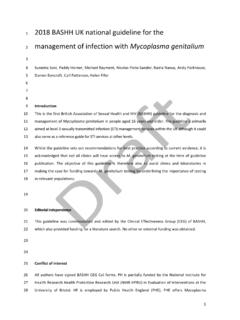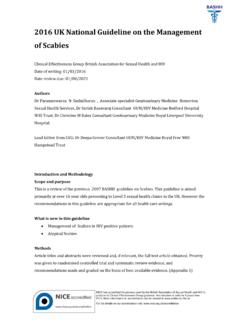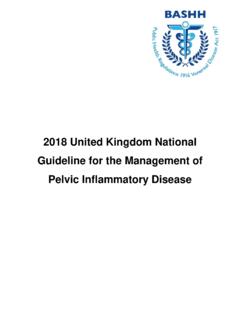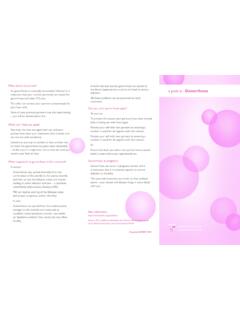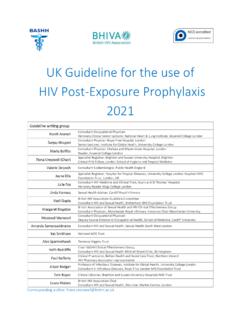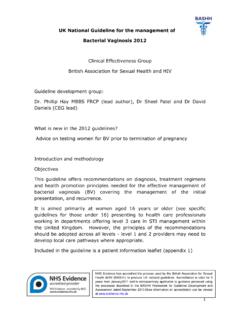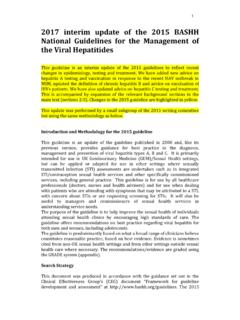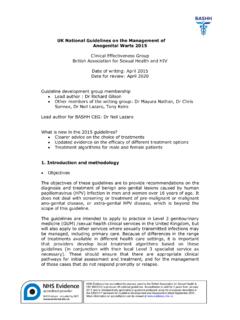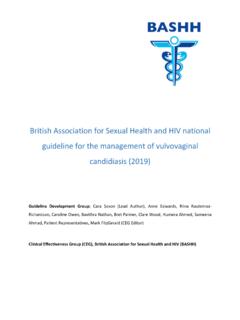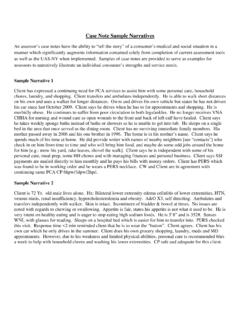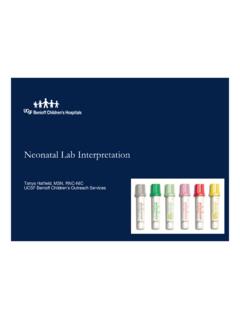Transcription of United Kingdom BASHH national guideline for the …
1 United Kingdom BASHH national guideline for the management of epididymo-orchitis, 2019 Clinical Effectiveness Group British Association for Sexual Health and HIV Dr Mimie Chirwa (co-chair), Specialty trainee, Genitourinary medicine, Chelsea & Westminster Hospital NHS Foundation Trust, London Dr Olubanke Davies (co-chair), Consultant, Genitourinary medicine, Epsom & St Helier University Hospitals NHS Trust Mrs Sheena Castelino, Pharmacist, Genitourinary medicine. Guy s & St Thomas Hospitals NHS Foundation Trust, London Dr Mbiye Mpenge, Consultant microbiologist, Weston Area Health NHS Trust, Weston-super-Mare, Somerset Dr Farai Nyatsanza, Consultant, Genitourinary medicine, Cambridge Community Services NHS Trust, Cambridgeshire Dr Cindy Sethi, Consultant, Genitourinary medicine, Guy s & St Thomas Hospitals NHS Foundation Trust, London Mr Majid Shabbir, Consultant urologist, Guy s & St Thomas Hospitals NHS Foundation Trust, London Patient representative, recruited from a London clinic Dr Michael Rayment, Consultant, Genitourinary medicine.
2 BASHH Clinical Effectiveness Group Editor 2 New in the 2019 guideline Aetiology Tuberculous epididymo-orchitis following BCG bladder instillation for bladder cancer Consideration of non-infective pathologies such as vasculitis and rare infections such as brucella where indicated in the clinical history Further investigations Brucella serology should be considered in patients from a brucellosis endemic area Colour duplex ultrasonography (CDU) is not reliable enough to make a diagnosis of testicular torsion in all settings as it has a user dependent false negative rate. It is recommended that patients with suspected clinical torsion should undergo an urgent exploration of the testis Treatment First line empirical treatment for epididymo-orchitis most probably due to any sexually transmitted pathogen is now with ceftriaxone 1g intramuscularly and Doxycycline 100mg twice daily for 14 days Consideration of 1g ceftriaxone intramuscularly + ofloxacin 200mg twice daily for epididymitis likely caused by sexually transmitted chlamydia and gonorrhoea and enteric organisms Consideration of ofloxacin 200mg twice daily or levofloxacin 500mg once daily for epididymo-orchitis most probably due to enteric pathogens Where Mycoplasma genitalium has been tested and identified, treatment should be guided to include an appropriate antibiotic ( moxifloxacin) Sexual partners Sexual partners should be tested for other STIs including HIV testing and given treatment with antibiotics to cover C.
3 Trachomatis and N. gonorrhoeae if confirmed in the index patient Follow up Uropathogen confirmed epididymo-orchitis is an indication for urology referral in order to exclude structural abnormalities/urinary tract obstruction 3 Scope and purpose The main objective of these guidelines is to offer recommendations on the diagnostic tests, treatment and health promotion principles in the effective management of epididymo-orchitis. It is aimed primarily at the care of people aged 16 years or older presenting to health care professionals, working in departments offering level 3 care in STI management within the United Kingdom . However, the principles of the recommendations could be adopted at all levels. Rigour of development The British Association for Sexual Health and HIV: 2015 framework for guideline development and assessment ( ) was used to develop these guidelines. A Medline search was performed for 2009-2017 using the keywords epididymitis , orchitis and epididymo-orchitis.
4 The Cochrane Database of Systematic Reviews and the Cochrane Controlled Trials Register up to 2017 were reviewed using the same keywords. Conference abstracts for British Association of Sexual Health and HIV, Federation of Infection Societies, and urology conferences were reviewed as were guidelines from Centers for Disease Control and Prevention, European Association of Urology, and International Union against Sexually Transmitted Infection guidelines. Further references from articles identified were included. Article titles and abstracts were reviewed and full texts of relevant articles reviewed. Meta-analyses of randomised controlled trials (RCTs), RCTs and systematic reviews were prioritised and recommendations were made and graded based on the best evidence available. A patient representative was recruited from a London sexual health clinic. They were involved in the development of the first and later drafts of the guideline as well as the patient information leaflet.
5 An equality impact assessment was undertaken and is published on the BASHH website. Prior to publication, the guideline was appraised using AGREE II by CEG, and then placed on the BASHH website for a two-month consultation period inviting all BASHH members to submit comments to the CEG. The guideline was also reviewed by the BASHH Public Panel. This guideline will be updated no later than 5 years after publication. 4 Introduction Acute epididymo-orchitis is a clinical syndrome consisting of pain, swelling and inflammation of the epididymis +/- testes. This may result from infectious and non-infectious pathologies. The most common route of infection is local extension and is mainly due to infections spreading from the urethra (sexually transmitted pathogens) or the bladder (urinary pathogens). Aetiology Bacterial Under 35 years - most often a sexually transmitted pathogen such as Chlamydia trachomatis and Neisseria gonorrhoeae [1-12]. Over 35 years - most often non-sexually transmitted gram negative enteric organisms causing urinary tract infections [1-12].
6 Particular risks include recent instrumentation (such as prostatic biopsy and vasectomy) or catheterisation [13-16]. There is crossover between these groups and complete sexual history taking is imperative [3, 7-9, 11, 12]. Men who engage in insertive anal intercourse are at risk of epididymitis secondary to sexually transmitted enteric organisms [1, 17, 18]. Abnormalities of the urinary tract such as anatomical or functional abnormalities are common in the group infected with Gram negative enteric organisms. Approximately 20% of male cases with anorectal malformations (ARM) develop epididymo-orchitis [19]. In cases of suspected edidymo-orchitis with a history of ARM, a recto-urinary communication or neurogenic bladder following anoplasty should be considered [19,20]. All patients with a confirmed urinary tract pathogen should have further investigations of the urinary tract [21,22]. Ureaplasma urealyticum is found in men with epididymo-orchitis, often in association with N.
7 Gonorrhoeae or C trachomatis infection. Evidence supporting it as a common cause of epididymo-orchitis is lacking [5, 12, 23] Mycoplasma genitalium is a slow-growing micro-organism, replicating intracellularly and extracellularly and able to establish latent or chronic infections (24). An association with epididymitis is biologically plausible. It has been identified in some cases of epididymo-orchitis but evidence for its role in development of epididymo-orchitis is so far lacking [23,25]. There has been a reported case of Panton Valentine leukocidin (PVL) positive strain of Staphylococcus aureus in a healthy individual presenting with scrotal pain with folliculitis and superficial abscesses [26]. Viral Mumps is a notifiable disease which should be considered as an aetiology since the epidemic in 2005 [27]. This epidemic mainly affected non-immunised adults born between 1982 and 1986. This complication of mumps (presenting with unilateral or bilateral orchitis) can occur in up to 40% of post-pubertal males [28-30].
8 Other viral pathogens such as adenovirus and enterovirus have been reported in children, presumed to be a result of post viral inflammation of the epididymis. This is a self-limiting condition [31]. Granulomatous Extrapulmonary tuberculosis represents 40-45% of TB cases in the UK [32], but tuberculous epididymo-orchitis is a rare presentation. It is likely to present in patients from high 5 prevalence countries or with a previous history of tuberculosis and particularly in patients with immunodeficiency [33,34]. It is usually as a result of disseminated infection and commonly associated with renal TB but can be an isolated finding [33-35]. Tuberculous epididymitis has also been increasingly reported as a complication of BCG instillation for treatment of bladder carcinoma [36,37]. Other infective causes Rare infective causes include brucella, fungi such as candida [38], and schistosomiasis [39]. Brucellosis should be considered in patients from endemic areas [40] such as the Mediterranean countries of Europe, north and east Africa, the Middle East, south and central Asia and Central and South America.
9 In non-endemic countries, diagnostic suspicion should be raised in the context of travel history to an endemic area, failure to respond to first line antimicrobial therapy and/or a history of preceding fever, lethargy and night sweats [41]. Non-infective causes 12-19% of men with Behcet s disease develop epididymo-orchitis. This is non-infective and thought to be part of the disease process. It is associated with more severe disease [42]. Unilateral and bilateral epididymo-orchitis has also been reported as an adverse effect of amiodarone treatment and will resolve once treatment is ceased [43,44]. Epididymo-orchitis is a rare manifestation of Henoch-Sch nlein purpura (the commonest vasculitic disease in children) [45-48]. Other rare non-infective causes include Familial Mediterranean fever [49] and polyarteritis nodosa [50,51]. Clinical features Patients with epididymo-orchitis typically present with acute onset unilateral scrotal pain, swelling and erythema [52].
10 Patients may complain of symptoms of urethritis or urethral discharge but these symptoms may be absent [8,9,12,53]. In addition, they may have symptoms in keeping with a urinary tract infection such as fever, dysuria, frequency and urgency. Testicular torsion (torsion of the spermatic cord) is the most important differential diagnosis. This is a surgical emergency that should be considered first in all patients, particularly young men, as testicular salvage is required within six hours and success diminishes with time [54-56]. Testicular torsion occurs most commonly in the neonatal period and around puberty; however, it can occur at any age. The pain is typically sudden occurring within hours, and is usually severe in nature [55-57]. The pain can radiate to the groin or lower abdomen and is often associated with nausea and vomiting. Patients may also report similar pain that improved without intervention in the past (intermittent torsion). In torsion, the testis is typically more tender than the epididymis, and the torted testis is often swollen and high riding with a horizontal position.
